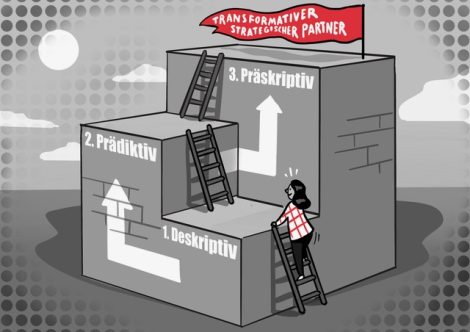People Analytics: Businesses (under)value personnel-related data

In many areas of organizations, the interpretation of enormous amounts of data has long provided the basis for well-founded, and value-adding decisions for corporate success. In terms of improving human resources work however, the analysis of a company’s own personnel-related data (people analytics) has so far been spurred on with very different levels of maturity. Can a classification of a company’s development status provide orientation and ease the introduction and expansion of people analytics functions?
Whether financial, risk & regulatory, supply chain, or customer analytics: using essential data has become indispensable in many sectors. For some companies, however, the question still arises of how to start this process so that the role of HR can be developed into a strategic partner for corporate success.
Though, people analytics is nothing new in HR management. As early as 1984 the pioneer Jac Fitz-Enz published the first book on this topic with the title “How to Measure Human Resources Management”. Digital technologies, data science techniques, and big data have since increased the need and potential for building specific people analytics skills exponentially. They are already used in the different phases of hiring processes and the entire cycle of personnel planning and management (Isson & Harriott, 2016), including recruiting, acquiring, developing and retaining employees. Artificial intelligence (AI), the area with potentially disruptive innovative strength, is linked to this development. The application of AI in human resources includes scenarios that range from fluctuation prediction and applicant search to personnel deployment planning to sentiment analysis and data acquisition with intelligent information extraction and self-services for employees (Strohmeier & Piazza, 2015; Edwards, 2019; Kryscynski et al., 2017).
In-house development status of people analytics
In science, people analytics in the narrower sense is usually described as a form of evidence-based management. Mühlbauer, Huff and Süß (2018), on the other hand, define it as applied empirical behavioral science. According to their approach, people are analyzed as individuals or in groups such as teams or departments and based on their behavior in the company. Based on that, actual situations are described, analyzes of contexts are evaluated, prognoses for the future are made, and implications for action are derived.
Taking existing scientific literature into account, the authors developed a maturity model that allows a classification of the methodological maturity of the analytical procedures used in the respective company. The differentiation takes place in three basic development stages and thus levels of maturity of people analytics (Fig. 1). They differ in parameters such as level of difficulty, values, and intelligence.
The descriptive analysis: use the first data and make optimizations
Descriptive analytics describe the analysis of past-oriented internal and external organizational (benchmarking) data as well as information from HR management. Such can be the number of employees and trainees, the recruitment and fluctuation rates, the percentage of full-time or part-time employees or the average age. Here we can meter whether a development is in the area of expectation. However, descriptive analytics do not analyze why a development came about or how it can be counteracted. Therefore, this stage has only limited strategic use for HR.
The predictive analysis: dipping into the future
Predictive analysis answers the questions of what will happen in the future and why. For example, whether the introduction of variable compensation affects job performance of employees. Consequently, it’s about data-driven insights and making decisions based on predictions. Statistical procedures, data mining and advanced algorithms that can analyze process and workflow data are integrated here. At this stage, effective adjusting screws for influencing human resource management targets and the company’s success can already be identified.
The prescriptive analysis: identify targeted actions to achieve goals
The third stage, prescriptive analytics, is about completely redesigning decision-making processes based on the data evaluations. Events and developments of the future become visible and linked with possible consequences for the company. Strategic forecasts, such as the fluctuation probability of employees based on identified fluctuation drivers, become transparent. In addition to classic statistical methods, machine learning methods are also used here, which is understood as a sub-area of artificial intelligence (Strohmeier, S., Piazza, F., 2015).
The future of HR work is data-driven
Investing in people analytics and its maturity development is essential for corporate success, because through data-based decisions, smart algorithms and predictive models, e.g., in total workforce planning, recruiting or talent management, HR can do justice to its strategic value and increase its transparency and objectivity. Finally, an objective database is the key to evaluating the needs of customers and employees and designing HR processes with the greatest possible employee experience.

Illustration 1: Maturity model for people analytics from Mühlbauer, D., Huff, & J., Süß (2018)

